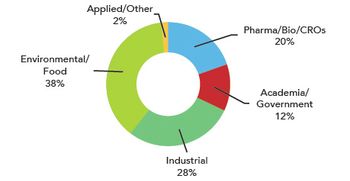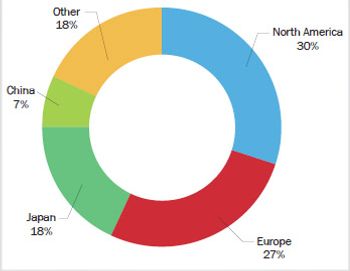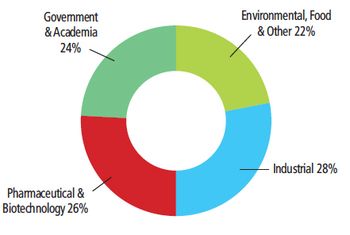
- Spectroscopy-11-01-2013
- Volume 28
- Issue 11
Market Profile: Secondary Ion Mass Spectrometry
Although mass spectrometers are more commonly associated with life science applications, there are some mass spectrometry (MS) techniques that are specifically designed for surface science applications.
Although mass spectrometers are more commonly associated with life science applications, there are some mass spectrometry (MS) techniques that are specifically designed for surface science applications. One of the most prominent such techniques is secondary ion mass spectrometry (SIMS). Like most surface science techniques involving electron or ion optics, SIMS is carried out under vacuum conditions. An ion beam is directed at a spot on the surface of the sample, sputtering atoms off of the sample surface. These secondary ions are introduced into the mass spectrometer for analysis. Several options are commercially available for the mass analyzer, including single-quadrupole, time-of-flight, and magnetic-sector instruments. The mass analyzer provides the elemental composition of the sample directly beneath the ion beam. To build up a two-dimensional image of the surface, the ion beam is rastered across the sample. The ion beam can also be used to sputter away the sample layer by layer, allowing depth profile analysis.
SIMS market demand by industry for 2012.
SIMS is commonly used to analyze semiconductor materials and other materials used in electronics, such as data storage media. The sensitivity to the surface layer allows SIMS to analyze thin films that are deposited on these materials. SIMS is also used in research laboratories in both academic and government settings. Although materials analysis applications are common here, there are also some environmental applications in the analysis of particulate matter making up air pollution. The total market demand for SIMS amounted to less than $100 million in 2012.
The foregoing data were adapted and extracted from SDi's market analysis and perspectives report entitled Mass Spectrometry: Limitless Innovation in Analytical Science, October 2013. For more information, visit
Articles in this issue
about 12 years ago
Surface-Enhanced Raman Scattering for Biofilm Characterizationabout 12 years ago
Ion Mobility Spectrometry: Solo or Coupled to Mass Spectrometryabout 12 years ago
Trends in Infrared Spectroscopic Imagingabout 12 years ago
How to Select an ICP-MS System: Some Important Considerationsabout 12 years ago
Vol 28 No 11 Spectroscopy November 2013 Regular Issue PDFNewsletter
Get essential updates on the latest spectroscopy technologies, regulatory standards, and best practices—subscribe today to Spectroscopy.




